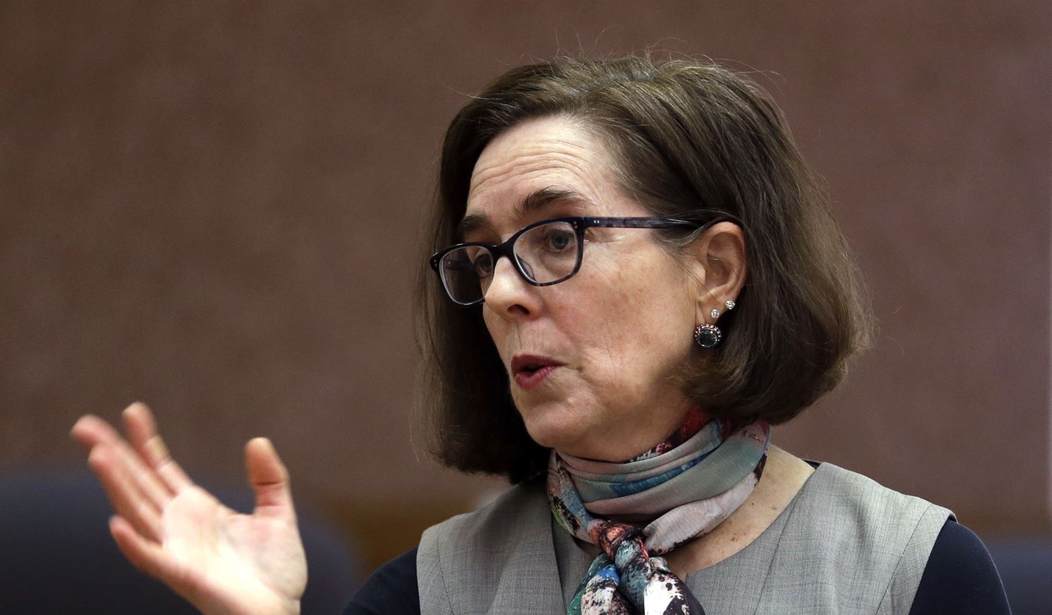On Friday, Oregon Governor Kate Brown held a press conference to discuss the latest developments in the containment efforts of the Wuhan coronavirus, and how to implement safe reopening procedures for different parts of Oregon. She failed, however, to announce the specific framework of the reopening, and said she would extend the emergency declaration until July 6 — two days after Independence Day.
Although Brown has announced a gradual plan to allow businesses to reopen, her emergency declaration gives state agencies the ability to set their own rules for a longer period.
As of this past weekend, Oregon had 2,690 cases of COVID-19 and 109 deaths, putting them near the bottom of states in both numbers.
In her press conference, Brown said right off the bat, “I want to be clear. We will not be able to reopen Oregon quickly, or in one fell swoop.” She said that some rural counties could reopen by May 15, but it could take longer in counties with more than five cases of COVID-19.
Protesters Descend on Salem to Show Gov. Kate Brown Oregon Wants to Reopen
Brown sent a document to all Oregon counties after the press conference — and after 5 p.m. on Friday — outlining the parameters for reopening:
1. Declining prevalence of COVID-19: This prerequisite only applies to counties with more than five cases. The percentage of emergency department visits for COVID-19-like illnesses are less than the historic average for the flu at the same time of year. Additionally, there must be a 14-day decline in COVID hospital admissions for the county or region.
2. Minimum testing regimen: Health regions must be able to test 30 people for every 10,000 people in the region each week. They must prioritize people showing symptoms and anyone who came into contact with someone diagnosed with COVID-19, including people living in congregate settings where someone tests positive.
Frontline and essential workers, as well as industries where ideal physical distancing is not possible, must be tested frequently. Health regions need to have enough testing sites for everyone living there and publicize where and how people can get tested. Low-income and underserved communities need to be able to access testing.
3. Contact tracing system: Contact tracing entails tracking down, and making contact with, anyone who may have been exposed to the virus. Counties need at least 15 contact tracers for every 100,000 people living there and be prepared to contact trace 95% of new cases within one day. Contact tracers must be able to carry out their work in a culturally appropriate way; they must be bilingual and multi-cultural.
Gov. Brown, along with Oregon Health Authority and Oregon Health & Science University (OHSU), announced the state’s robust testing and contact tracing plans on Friday. Part of their strategy is a new year-long study called “Key to Oregon”, where OHSU will collect data from 100,000 randomly selected volunteers.
“This program is a game-changer. It will give us a more accurate understanding of the true rate of infection in Oregon and have ongoing precision monitoring of any new outbreaks,” Brown said.
“We won’t eliminate the spread of COVID-19 in Oregon with people being able to infect others before they have symptoms – or even those who never have symptoms,” Oregon State Health Officer Dr. Dean Sidelinger added, “But we hope to slow it as much as we can.”
4. Isolation facilities: Counties specifically need hotel rooms for people who test positive and can’t self-isolate. Counties must also have a plan for how they will respond to different outbreaks at a nursing home, jail, food processing facility, farmworker housing, or other group living situation.
5. Finalized statewide sector guidelines: OHA and other groups are working together on sector-specific guidelines. Every sector must adhere to those in order to protect its employees and customers and make the physical workspace safer.
6. Sufficient health care capacity: Hospitals across health regions need to be able to handle COVID patients and other sick people. Each region has to be able to handle a 20% increase in suspected or confirmed COVID hospitalizations, compared to the number of hospitalizations in that region when the governor’s executive order was issued in March.
If the regional hospital capacity is under that level, an individual county can’t move into the first phase of reopening.
7. Sufficient personal protective equipment (PPE) supply: Larger hospital systems need a 30-day supply, while smaller hospitals need enough gear for 14 days. All hospitals in the health region have to report their daily PPE supply to OHA. Counties must prove they have enough PPE for first responders.
Brown’s press address gave mixed messages and made it seem that she’s failed to grasp the serious damage being done to Oregon’s economy. Meanwhile, these requirements for reopening will take a significant amount of time to implement. While other states have taken strides to reopen their economies and activities, Oregon has yet to make progress. In fact, state parks will stay closed through May, and probably longer. The third requirement for reopening, 15 contract tracers for every 100,000 in population, will require the state to recruit over 600 people to participate, and then to produce results, before they can even consider when to open. Brown first declared an emergency on March 8. She apparently squandered the first two months of the shutdown and only now has gotten around to deciding what conditions will allow her to let Oregon work again.
Portland Goes Full Totalitarian, Will Close Streets To Encourage Distancing
In the meantime, Brown still has not convened an emergency session of the legislature and has not brought her emergency declarations in line with state law. In addition, Brown has caused confusion with the separation of the state into regions, instead of relying on individual counties and supplying them with sufficient resources to safely reopen. On Friday, officials in Jackson County in southern Oregon complained that Brown had failed to share resources meant for them in the CARES Act:
Officials with Jackson County are calling on Governor Kate Brown to distribute CARES Act funding to local agencies, claiming that the only major funding distributed so far has gone to Oregon’s urban areas.
“The cities, counties, businesses and people in Oregon have done an amazing job of doing what they have been asked to do in order to meet the statewide guidelines put in place by Governor Kate Brown,” said Jackson County Commissioner Colleen Roberts, “Jackson County has been doing our part on our own dime with the anticipation that the first wave of the Coronavirus Relief Fund CARES Act, Title V funding would be reallocated to local governments in our county as intended by Congress.”
According to the County, $1.635 billion from the CARES Act went to Oregon for local relief efforts. Hundreds of millions went to the City of Portland, Multnomah and Washington counties directly — but Governor Brown is responsible for distributing the rest to less populated cities and counties in the state.
As it stands, Oregon will remain largely locked down until after Independence Day. That date almost seems symbolic for Kate Brown.
Jeff Reynolds is the author of the book, “Behind the Curtain: Inside the Network of Progressive Billionaires and Their Campaign to Undermine Democracy,” available now at www.WhoOwnsTheDems.com. Jeff hosts a podcast at anchor.fm/BehindTheCurtain. You can follow him on Twitter @ChargerJeff.
Editor’s Note: Want to support PJ Media so we can keep telling the truth about China and the virus they unleashed on the world? Join PJ Media VIP and use the promo code WUHAN to get 25% off your VIP membership.










Join the conversation as a VIP Member